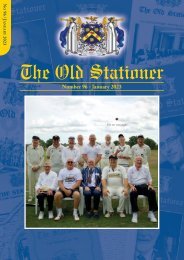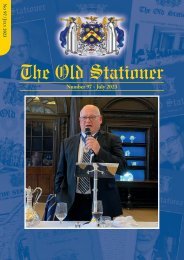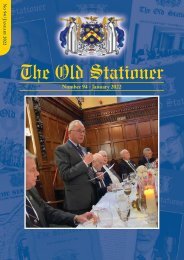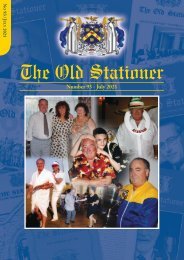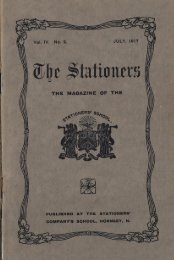OSAmag91
You also want an ePaper? Increase the reach of your titles
YUMPU automatically turns print PDFs into web optimized ePapers that Google loves.
T h e O l d S t a t i o n e r - N o 9 1
From left,Graham Rawlings, Andy Pinches, Richard Taylor,
? ,Danny Bone, Peter Boddington
Now we come to the most interesting point of this short memoir.
I along with a number of my peers had been led to believe that
all French girls were sex mad and easy prey for us dashing young
Stationers. Unsurprisingly, this of course turned out to be a
complete lie, not that we met many girls on the trip but those we
did had no interest in us – well, me at least – others may tell a
different story. However, as a good boy scout I had gone along
prepared with a newly purchased packet of condoms. These
remained tucked away in the back of my rucksack only to be
uncovered when my mother did the washing on my return home.
Needless to say I was challenged by my father. My simple
defence was that one of my cohort had planted them!
Roger Turkington
My experiences as a navigator
flying in the DeHavilland
Mosquito Tony Grist
I was 19 years old when I first flew in a “Mossie.” After sixteen
months of aircrew selection, officer cadet training, basic air
navigation and advanced air navigation schools, I was posted to
a bomber command station at Bassingbourn, near Cambridge.
This was an operational conversion unit to train for a role as a
navigator of the RAF bombers. Apart from navigating a few two
to three hour cross country exercises with experienced Mosquito
pilots I had to crew for pilots who had graduated from single
engine Harvards and were “ converting “ to twin engines. There
were no dual-control Mosquitos where a pilot new to the aircraft
could be taught side by side by an experienced pilot. They were
thrown in at the deep end.
The Mosquito is powered by two Rolls Royce Merlin engines
whose propellers both rotate in the same direction. It also has a
very short keel (distance between the main landing gear and the
tail wheel.) The result of the props rotation and the short keel was
a torque which tended to swerve the aircraft on touching down in
the stalled position. An over correction with the rudder and
brakes would result in a sideways force on the main landing gear
which caused it to collapse. One alternative was to not overcorrect
and allow the plane to go off the runway onto the grass.
The commanding officer in charge of pilot training insisted that
his students land the aircraft in a three point stalled attitude as
they had been taught on the Tiger Moths and Harvards. The C
O had the damaged planes towed to the upwind end of the
runway as a warning to his pupils! This did nothing to improve
their nerves. Night flying was conducted with goose neck
kerosene lanterns spaced along the runway to outline its
boundaries. A trip off the runway into the grass usually resulted
in hitting one or more flare pots and the debris wound up
decorating the tail plane. After nearly four months and being the
only navigator left, not in hospital, I considered myself lucky to
be posted to Halfpenny ( pronounced Haypney ) Green near
Wolverhampton for a three month radio operator’s course.
After completing wireless school I wound up being posted to the
overseas ferry unit of transport command at Abingdon near
Oxford. My next experience with a Mosquito was in March of
1953. I was slated to crew with Flight Sergeant Witold Lanowski
to ferry a Mosquito (T3 VP349) from Abingdon to Singapore.
The first leg was from Abingdon to Istres, near Marseilles. It was
a routine trip and I had folded my charts in preparation for the
landing. There was a small tin of hard candies sitting behind the
rudder trim in the centre of the dash. Witold flew the aircraft
onto the runway landing on the front wheels with the tail up and
full directional control with airflow over the rudder, slowly
lowering the tail as we lost speed. We touched with a slight jolt
and the candies popped into the air. Switching hands, he took his
left hand off the throttles and onto the stick, caught the candies
with his right hand and put them in his lap. We continued right
down the centre of the runway. To say that I was impressed
would be a monumental understatement. The CO at
Bassingbourne should have taken lessons from him.
Witold Lanowski is mentioned in “Goodbye Mickey Mouse” by
Len Deighton, my favourite author of the “spy” genre.
I later learned that Witold flew with the USAAF in 1944 and
served without pay for several months. There was talk of this on
our squadron (167) at the time and he had the reputation that his
love of flying was greater than his need for money as long as he
was provided with a bed and food! With the support of a senator
from Wisconsin he later successfully sued the U S government
for his back pay. It seemed manifestly unfair to me at the time
that this seasoned veteran and experienced pilot should have the
rank of Flight Sergeant and that I was a 20 year old inexperienced
sprog holding a commission. At the end of each leg we each went
to our separate messes. I couldn’t even buy him a beer!
The Mosquito was not the easiest plane to get in and out of. Nor
was it the ideal office for a Nav/Wop. Entrance was through a
panel on the lower starboard side of the nose, ahead of the bomb
bay doors. It was about five feet off the ground and roughly two
and a half feet square. The pilot had to get in first, crawling past
the navigator’s seat into the left hand side. From the entrance
hatch to the cockpit floor was another two up. It required a lot
of upper body strength to heave yourself into place, and once
there, only an emergence or a safe landing was motivation to
change your position. You always had a pee just before a flight.
On top of my flying suit I wore a parachute harness and dingy
pack strapped to my bum which fitted into an indent in the
bottom of the aluminium seat. Maps and plotting charts were
17



